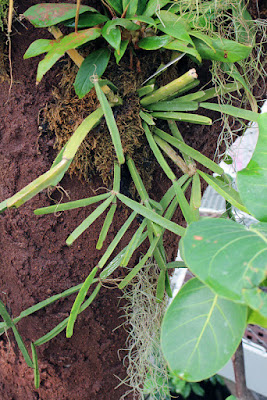Rhipsalis cereoides is endemic to Brazil. It is found in southern Espírito Santo (Domingos Martins); Rio de Janeiro (both sides of the Baía de Guanabara). It grows in southern humid forest (inselberg) element: lithophyte on gneissic inselbergs (rarely epiphytic on nearby trees) at elevations of near sea level to 900 metres above sea level.
Rhipsalis cereoides also called as Lepismium cereoides, is a species of the genus Rhipsalis. This species was described by Curt Backeberg in 1937.
IDENTIFY RHIPSALIS CEREOIDES CACTI
Rhipsalis cereoides is endemic to Brazil. It is found in southern Espírito Santo (Domingos Martins); Rio de Janeiro (both sides of the Baía de Guanabara). It grows in southern humid forest (inselberg) element: lithophyte on gneissic inselbergs (rarely epiphytic on nearby trees) at elevations of near sea level to 900 meters above sea level.
It is a lithophyte, rarely epiphyte, 30-100 cm long, branching apical with acutely 3-angled. rarely 4-sided, 4 - l0 cm long., to 1.7 cm thick stem, the angles often offset on successive segments with small, scales minute areoles, with traces of felt, with 2 - 4 short weak branches.
The flowers are to 3 - 4 at one time, white, spreading. The petals are convex. The fruit are spherical, olive-green at first. then transparent light pink. The seed are glossy dark brown, numerous.
RHIPSALIS CEREOIDES CACTI CARE AND CULTURE
Cultural information should only be used as a guide, and should be to be adapted to suit you. Your physical location; where you grow your plants, how much time you have to devote to their care, and many other factors, will need to be taken into account. Only then can you decide on the cultural methods that best suit you and your plants.
Light and exposure:
Rhipsalis cereoides do best in a light to partially shaded location without too strong sunshine. Ideal locations are east or west-facing windows. South windows are also suitable, but the strong sun must be significantly weakened by curtains or shade of others plants.
Humidity:
A high humidity, about 50 to 70%, is very beneficial for this species. At a sufficiently high humidity, this cacti develop healthy and develop magnificently, as long as the other care needs are sufficiently fulfilled.
Temperature:
The ideal temperature range is between 18 and 24 ° C throughout the year. The nighttime temperatures can drop quite a few degrees, but fluctuations of more than 10 to 12 ° C within one day should be avoided.
Soil:
A nutrient-rich, humus-rich substrate is used. Choose a loose, medium-sized soil with enough nutrients. Commercially available quality grounds for potted plants have all the important characteristics to ensure the healthy growth of cacti.
Potting and repot:
It is best to plant Rhipsalis cereoides in March or April. During the winter, these cacti should not be repotted. Carefully remove the plant from the pot and clean carefully. Then you put the cactus back in and add fresh soil as needed. Since these cacti form only a few and small roots, you usually do not need larger pots. To repot, the old soil is shaken out of the roots, and all dead dead roots of the cactus are carefully cut off. A well-transplanted cactus is recovering quickly and will soon continue to grow.
Watering:
During the active growth in spring and summer, the plants should be watered evenly. This cacti must never be completely dry out. Cause this epiphytic growing cacti are very sensitive to lime, you should only use soft water. It is best done with clean rainwater. If don't have this, you can soften the tap water with a water filter. In winter, this cacti are watered moderately.
Fertilizer:
To support bud formation, these cacti are fertilized every 14 days. Use mineral fertilizers diluted in half, it is also necessary to use fertilizers with an average nitrogen content, an excess of nitrogen is contraindicated for cacti, as it contributes to rotting of the roots. Once a part of the buds have opened, the fertilizer is completely stop. Too much fertilizer is harmful to the plants.
Rest period:
Rhipsalis cereoides does not need a rest period and is maintained all year round at constant room temperatures. Pay attention throughout the year to a uniform soil moisture and the highest possible humidity.
Pruning:
The plants easily tolerates a pruning, preferably in early spring. Too long shoots shortened to a maximum of 2/3 of their length.
Propagation:
Seeds of Rhipsalis ripen freely, and these, if sown on sandy soil, and placed on a shelf in a warm house, germinate in a few days.
These plants are best propagated by cuttings in the period from spring to summer. Cut the cactus 8 to 15 cm long, healthy shoot. Then the cuttings are placed in small groups of several copies about 3 to 4 cm deep directly into the recommended substrate for these cacti. In the next 3 to 4 weeks you keep the substrate only slightly damp, then you can treat the young cactus like adult specimens.

















COMMENTS